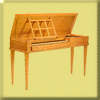 |
|
Clavichord after Manuel Carmo, Porto 1796, 1,42m long, compass FF - f³, bichorded, tuning pitch a' 415 Hz, unfretted (each note has its own pair of strings) from FF - kl d, fretted, notes produced from a single set of strings from kl dis - f³, whereas the d and the a are unfretted, naturals with boxwood key-tops, sharps in ebony, four unscrewable legs |
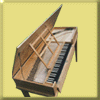 |
|
Clavichord after Joh. Heinr. Silbermann, Straßburg, 1,42m long, compass FF - f³, bichorded, with brass strings, tuning pitch a' 415 Hz, unfretted, naturals with ebony key-tops, sharps in ebony with bone key-tops, four unscrewable legs |
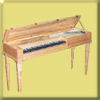 |
|
Clavichord after Christian Gottlob Hubert, Ansbach 1787, 1,40m long, compass AA - f³, brass strings, tuning pitch a' 415 Hz, fretted, notes produced from a single set of strings, although a + d are unfretted, the bass is unfretted as of the kl d, naturals with ebony key-tops, sharps in ebony with bone key-tops, four unscrewable legs
|
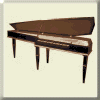 |
|
Cembal d' Amour after Gottfried Silbermann 1721, Length 2,35m, compass FF - f³, tuning pitch a' = 415 Hz, naturals in ebony, sharps with bone key-tops, five unscrewable legs
|
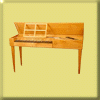 |
|
Clavichord after C. P. E. Bach, 1,50m long, compass FF - f³, bichorded, tuning pitch a' 440 Hz, naturals with ebony key-tops, sharps in ebony with bone key-tops, four unscrewable legs |
 |
|
Clavichord according to Christian Gottlob Hubert, Ansbach 1772(?), length 1,65m, compass FF-f³, unfretted, bichorded, with brass, a' 415Hz, naturals with ebony-layer, sharps in ebony with bone key tops. As in the original instrument, the touch can be regulated by adjusting a pressure bar behind the tangents. Taking the pessure bar off makes the attack (and thus the sound) less incisive. |
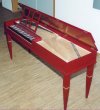 |
|
Clavichord after Joh. Chr. Fleischer, Hamburg 1729, compass FF - f''', FF - d with octave-strings, length 1,70m, bichorded with brass, a' = 415 Hz, unfretted, naturals with ebony-layer, sharps with bone keytops, four unscrewable legs
|

















